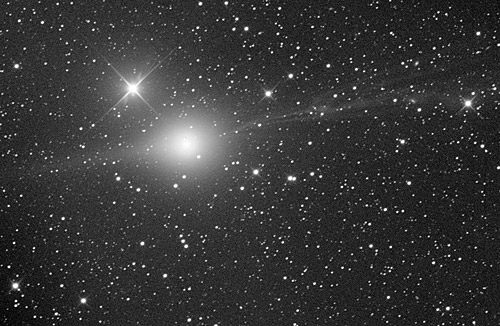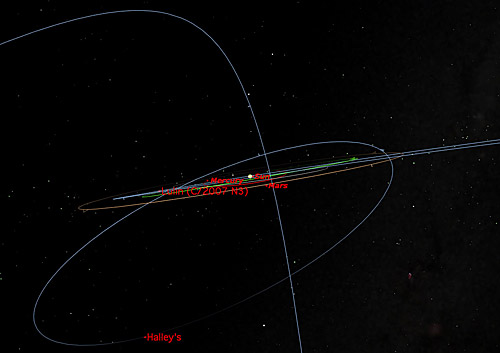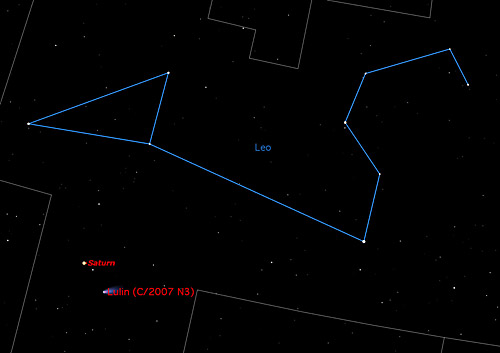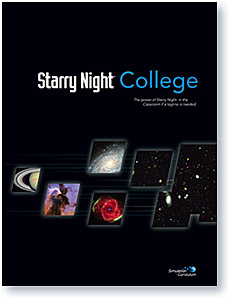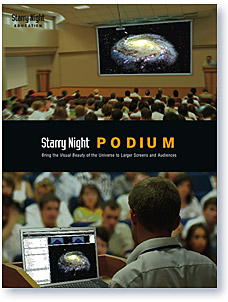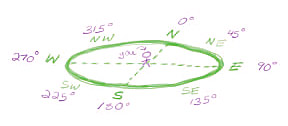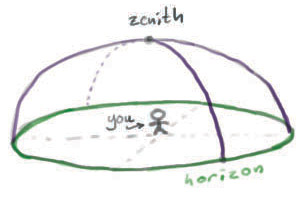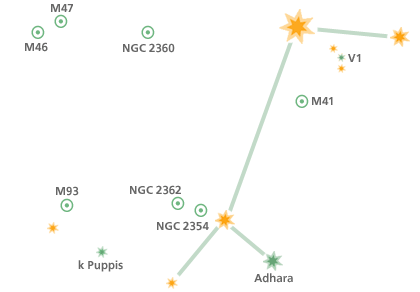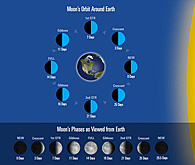 |
||||||||||||||||||||||||||||||||||||||||||||||||||||||||||||||||||||||||||||||||
|
If you have trouble viewing this newsletter, click here. Welcome again to our monthly educational newsletter with features on exciting celestial events, product reviews, tips & tricks, and a monthly sky calendar. We hope you enjoy it!
Comet Lulin (C2007 N3) was discovered in 2007 by a team of Chinese and Taiwanese astronomers centered around Lulin Observatory in Taiwan. It was originally spotted in China, and its position reported to Lulin Observatory where it was imaged and its orbit calculated. This is a remarkable example of cooperation between scientists of two countries usually thought to be at odds with each other. At the time of its discovery in July 2007, Comet Lulin was located between the orbits of Jupiter and Saturn in the constellation Aquarius. It was closest to the Sun on January 10, but still far from Earth, 1.6 astronomical units away. By the time it reaches its prime observing period in February this year, it will be speeding through Libra, Virgo, and Leo. It will be closest to Earth on February 24, when it will be just visible to the naked eye in a really dark sky, but an easy object in a small binocular. On that date, it will be less than three degrees away from the planet Saturn, making for a remarkable sight. Here is a view of Comet Lulin as it passed 47 Librae, captured by Canadian astronomer Paul Mortfield on January 8 using his remote telescope in Arizona:
All of this information (except for the history of its discovery), plus a whole lot more, is available to anyone using Starry Night® software. Starry Night® provides two quite different ways of looking at a comet like Lulin. First of all, you can track the comet as it wends its way through the solar system. Secondly, you can follow its actual movements in the sky. Since most people are less familiar with the first use of Starry Night®, I’ll spend more time on that. Starry Night® provides the unique opportunity to view our solar system from outside, and to navigate around it in three dimensions. This enables us to visualize the orbits and movements of solar system objects in many unique ways. Starry Night® comes with a number of "Favourites": preset views of the universe that we can use to explore things on our own. Let’s look at one of these now. Under the Favourites menu, choose Solar System:Inner Planets:Inner SolarSystem using the hierarchical menu system. This will show you an oblique view of the inner planets, Mercury, Venus, Earth, and Mars, surrounded by the asteroid belt. Click on the Stop button and then on the drop-down menu in the Date and Time box to choose "Now". This will give you a snapshot of the inner planets as they are located right now. You can use the "+" and "-" buttons to zoom in and out, and, from the cursor menu at the far left end of the toolbar you can select the Location Scroller cursor to view the solar system from different angles. Experiment with this cursor to see how it operates. By dragging downwards you can view the solar system from above the Sun’s north pole; by dragging upwards you can view the solar system edge on. Let’s add Comet Lulin to our solar system view. Click the Find tab on the left side of the screen to open the Find pane. Click on the magnifying glass and choose "Orbiting Objects." Type in "lul" to bring up Comet Lulin. Click in the two check boxes alongside "Lulin (2007 N3)": the first labels the current position of Lulin and the second turns on its orbital line. You’ll immediately see the typical comet orbit, in this case a highly eccentric ellipse since Lulin is a periodic comet. Use the Location Scroller to see how this orbit appears in both the "overhead" and "edge on" views. If you know anything about comet orbits, you’ll see that Lulin’s orbit is very unusual in that it is very close to the plane of the solar system, much like the planet orbits onscreen. Just for fun, add a couple of other comet orbits, say Halley and Hale-Bopp. You’ll see that their orbits lie nowhere near the plane of the solar system.
Now let’s follow Comet Lulin across the sky. First, add Comet Lulin to the sky the same way we did in the solar system view. Open the Find pane, limit the search to Orbiting Objects, and enter "lul". This time click only the box on the left, adding the label to the sky view. Set the Date and Time to when you plan to observe, say 5 a.m. on February 1. Comet Lulin starts the month right in the middle of the constellation Libra. If you open the Info pane, you’ll find an array of information about Lulin on that date, including its distance from the Earth (0.928 au), distance from the Sun (1.259 au), and apparent magnitude (7.33). Advance the date day by day, and you’ll see the comet move across the sky, and the Info pane data change. On February 11 it leaves Libra and moves into Virgo. On February 23 it moves into Leo, and its apparent magnitude reaches its maximum (5.99). On February 24 the Comet is closest to the planet Saturn. Notice how, as the Comet gets closer to Earth, its apparent speed across the sky increases. After February 24 it moves into the evening sky and seems to slow down, moving into Cancer on March 2 and Gemini on March 9. Starry Night® makes a prediction of the length and direction of its tail, and notice how this changes as it passes the Earth. Remember that comets’ tails always point away from the Sun.
As David Levy likes to say, comets are like cats: they both have tails and both do exactly as they please! Starry Night® shows Comet Lulin as it would appear if it were a well-behaved comet, but there really is no such thing. I’m sure Comet Lulin will give us a surprise or two, so I hope you will join me in trying to observe this interesting visitor to our part of the solar system. Clear skies! Geoff Gaherty
Starry Night® College (coming in 2009) Starry Night® College helps you teach a more satisfying course by making it easier for introductory astronomy students to visually grasp the concepts of astronomy. Starry Night® College is the ideal auxiliary companion to your introductory astronomy textbook and includes 45 computer exercises fully mapped to popular textbooks. Let Starry Night® College help pass on your enthusiast about the universe to your students. You’ll be amazed at what they will learn and what a great time they will have with your course and this program. Link: Starry Night® College
Starry Night® Podium (coming in 2009) Optimized for projection, Starry Night® Podium provides an intuitively designed interface on the operator's computer screen and projects an impressive, uncluttered view of the sky that brings the visual beauty and accuracy of Starry Night® to larger screens and audiences. Starry Night® Podium includes a library of pre-assembled interactive simulations, educational video clips and concept diagrams suitable for use in college level courses. You can add your own simulations, videos and images to this library. In lieu of a Planetarium Dome, Starry Night® Podium is the next best thing. Link: Starry Night® PodiumPlease contact Michael Goodman for pre-order information.
Telescope Observations that Changed the World Galileo made a number of observations that could not be explained with the accepted theories of the day. Old beliefs had to be re-examined. The visual observations made by Galileo and the work of Nicolaus Copernicus, Tycho Brahe and Johannes Kepler toppled the Earth-centered view of the universe, replacing it with the heliocentric (Sun centered) model. The previous and long-held assumption that the heavens were perfect in form was suddenly in doubt. 2009 marks the 400th anniversary of Galileo’s observations. Over the next few month’s we will use Starry Night® to relive the exciting discoveries that changed forever our view of the universe and our place in it. We encourage educators to follow along with us in their classrooms. Discovery One: Jupiter and its Moons Galileo’s first observations of Jupiter on January 7, 1610, revealed three "stars" in line with Jupiter’s equator. Galileo was not concerned by this observation as he believed they were fixed background stars. January 7, 1610
But on the very next day, he found a different arrangement: January 8, 1610
Galileo was puzzled by this observation and his thoughts were concerned with how Jupiter itself had moved relative to the fixed background stars. Further observations over the next few days revealed that these "stars" continued to change their arrangement around Jupiter. Galileo knew that these changes could not be attributed to Jupiter itself and came to the astonishing realization that these three ‘stars’ were moving around Jupiter. You can follow in Galileo’s footsteps using Starry Night®. Begin by downloading the file <Jupiter1610.snf>. Open this file with Starry Night® (File-Open). Starry Night® will display the night sky as seen by Galileo 400 years ago on January 7, 1610. Compare what you see in Starry Night® with Galileo’s sketch on January 7, 1610. How many "stars" or more accurately moons, do you see around Jupiter? How do your observations in Starry Night® compare to Galileo’s? Advance the time by one day and compare the view in Starry Night® with Galileo’s sketch on January 8, 1610. How do your observations compare with Galileo’s? Hint: Galileo’s telescope had a field of view of about 15 arc minutes. On January 13th, 1610 Galileo discovered an additional "star" which had escaped his earlier observations. These four "stars" are now know as the Galilean moons of Jupiter. Stay tuned to next month as we continue to relive the discoveries made by Galileo that changed our view of the universe. Herb Koller
The Local Coordinate System When you're standing on a roughly spherical object like the Earth, you have a horizon. The horizon is just the farthest part of the surface that you can see. Beyond that the surface has curved away below your line of sight. It's just like looking at the top of a hill – you can't see the other side of the hill because it's hidden by your side of the hill.
If the entire surface of the Earth was at the level that we call "sea level", a human being of average height would be able to see about 5 km (3 miles) in any direction before the surface curved away. This can be simulated by looking out over a body of water whose other side you can't see, such as an ocean or large inland sea or lake. Anything that inhibits you from seeing that far (like a hill, or a vantage point below sea level), or anything that allows you to see farther (like a valley, or a vantage point above sea level) is just a local variation. If you think of the horizon as a circle around you, you can specify which direction you're facing by stating a number of degrees – as long as the person you're talking to knows what frame of reference you're using. Fortunately, there are established standards for this sort of thing. Astronomers, map makers, and navigators use north as the starting point on the horizon, and move clockwise from there.
There's also a special word for it – if someone wants to know what direction you're facing around your horizon, they will ask for your azimuth. There's another circle on the sky that you can measure in degrees, although it's a bit less obvious. It goes from the horizon to the zenith (the point directly over your head) and straight through to the opposite horizon, and then underneath the Earth to come back up to the horizon where you started. More specifically, it's the quarter-circle that's important – from the horizon to the zenith. If you want to talk about how high up something is in the sky, you can use this quarter circle. Again, there's a standard – the zenith is called 90º, and if you backtrack 90º towards the horizon you reach 0º (which, as mentioned above, may or may not be exactly on the horizon that you can see, as determined by the lay of the land). If someone wants to ask you how high up in the sky you're looking, they will ask you for the altitude of your gaze.
Put all of that together, and you can specify the location of something in the sky, with respect to your location, by quoting an azimuth (which direction you're facing) and an altitude (how high up it is). This is called the altitude-azimuth or alt-az coordinate system. The weakness of the alt-az system is that it's glued to your location and your point in time. An object in the sky will rise and set as the Earth rotates, thereby changing its altitude and its azimuth from one moment to the next. An object that is directly over your head will be on the horizon for someone a quarter of the way around the planet, or below the horizon for someone further away! Next month we'll talk about a coordinate system that can be used more universally. Brenda Shaw
Laurent Cassegrain was one of several people in the 17th century to propose a telescope made from two mirrors, a paraboloid concave primary mirror and a hyperboloid convex secondary. The actual construction of such a telescope was beyond the optical craftsmen of the day, so it remained only a theoretical possibility until the end of the 19th century, when it rapidly because one of the most popular designs for professional telescopes. The convex secondary acted somewhat like a Barlow lens, resulting in a long focal length in a relatively short and compact tube. The main limitation on the popularity of this design was in its narrow field of view and the difficulty of making its mirrors. Two 20th century optical designers, Bernhard Schmidt and Dmitri Maksutov, solved this. They substituted spherical mirrors for the complex paraboloid and hyperboloid mirrors, and added corrector plates to correct the ensuing optical problems. Maksutov’s solution was to add a thick, deeply curved meniscus lens to the front of the telescope. In most Maksutovs, the secondary mirror is just a silvered spot on the back of the corrector, making the whole telescope fairly easy to construct:
The first commercial Maksutov-Cassegrain to appear on the market was the Questar in the mid 1950s. This was a compact jewel of a telescope: very fine optics at a very high price. It is also the only telescope from the 1950s that is still in production in the 21st century, more than half a century later. In 2001, Orion introduced a line of Maksutov-Cassegrains that offered exquisite optics at very reasonable prices. The astronomical versions were known as the StarMax series and the terrestrial versions as the Apex series, but the optics and tube assemblies were identical. Unlike most of the competing Maksutovs, Orion’s were built entirely from metal: no flimsy plastic parts. I purchased one of the first 127mm models, and found it a superb instrument for solar, lunar and planetary observation. I used it to observe transits of both Mercury and Venus across the Sun, and for memorable observations of Saturn and, especially, Jupiter. The Mak-Cass design has a number of advantages that make it a superb instrument for solar system and double star observing. These scopes have long focal ratios, so that high magnifications can be achieved with relatively simple and inexpensive eyepieces. I got excellent results with an Orion Ultrascopic 10mm eyepiece, which yielded 154x. When seeing conditions were excellent, I could use a 6mm eyepiece as well, yielding 257x, quite remarkable for a 127mm aperture! Because the secondary mirror is a spot on the back of the corrector lens, there are no spider supports such as are found in Newtonians. This produces a very clean in-focus image, with very high contrast. This was particularly helpful in observing a transit of Ganymede across the face of Jupiter. While satellite shadows are relatively easy to see on Jupiter, the satellites themselves usually blend in with the planet’s background. Ganymede appeared as a distinct grey disk as it passed in front of Jupiter. The main drawback of the Mak-Cass design, aside from its narrow field of view, is that it takes a long time to cool down to operating temperature. When I first tested the 127mm, I thought it had serious optical problems. After a couple of nights observing, I realized that these problems vanished after an hour or so, and the optics were, if fact, outstanding. Observing with a Mak-Cass requires a bit of advance planning, leaving the scope out to cool for an hour or so before observing, if maximum clarity and contrast are to be achieved. Orion’s original StarMax and Apex telescopes were available in 90mm, 102mm, and 127mm apertures. Because of the success of these models, they have added 150mm and 180mm models. I haven’t yet had the opportunity to try either of these "Big Maks," but, judging by the excellence of my 127mm model, they should be a treat for the serious solar system and double star observer. Geoff Gaherty
At Mag -1.5, almost everyone knows that Sirius is the brightest star in the night sky. You may notice it driving home from work: visible from early dusk, it sparkles brilliantly above the southern horizon. What many people don't realize is that Sirius is actually a double star. Sirius B is a challenging target, just 5" from Sirius and quite dim at Mag 8.5. It requires excellent optics but, if you can nail it, it's surely a feather in your cap. A little to the west of Sirius is a three star asterism, with the central star, V1, being an easy, pretty double separated by 17". M41 (also known as the Little Beehive) is a fine open cluster lying about 2,000 lightyears from the back of your eyeball. It has about 25 bright stars spattered across a field about the size of a full moon; in reality, they're spread over an area 20 lightyears in width. Bright enough to be sometimes visible to the naked eye (Aristotle is said to have noticed it around 325 B.C.) M41 is a good target for binos or low magnification in your scope. M46 and M47 are two open clusters just over 1° apart, making comparison very easy. Both are about 20 million years old but they're not connected in any way: M46 hangs in space about 5,000 lightyears distant, while M47 is closer at 1,700 lightyears. Of special interest is the planetary nebula that seems to be embedded near M46's center. Although the nebula is probably not actually part of the cluster (it simply lies along the same line of sight), it makes for a good opportunity to see two different types of deep sky object at the same time. In larger scopes, NGC 2360 (a.k.a. Caldwell 58) is a pleasing open cluster almost half way between M46 and Sirius. M93, the winter Butterfly Cluster, is a rich 6th Mag open cluster with about 80 visible stars. It's core resembles an arrowhead. While you're in the area take a look at k Puppis, a nice bright double. NGC 2362, the Mexican Jumping Star (a.k.a. Caldwell 64), and NGC 2354 are another pair of closely placed open clusters worth comparing. Finally, Mag 1.5 Adhara has a Mag 7.5 double just 7.5" due south. Adhara is a main sequence star that shines 9,000 times as brightly as our own sun. Good thing it's 432 lightyears away. Sean O'Dwyer
Steve Umland took this image old school with Kodak 120 film on a Fuji panoramic camera. Cabin was a combination of three different exposures for different lights in the cabin. Combined cabin exposure around twenty minutes. Exposure for stars was 3.5 hours.
RULES: We would like to invite all Starry Night® Education users to send their quality astronomy photographs to be considered for use in our monthly newsletter. Please read the following guidelines and see the submission e-mail address below.
|
FEB 2009
|
|||||||||||||||||||||||||||||||||||||||||||||||||||||||||||||||||||||||||||||||
 |
||||||||||||||||||||||||||||||||||||||||||||||||||||||||||||||||||||||||||||||||
|
|
||||||||||||||||||||||||||||||||||||||||||||||||||||||||||||||||||||||||||||||||
You have received this e-mail as a trial user of Starry Night® Digital Download
or as a registrant at starrynight.com. To unsubscribe, click here.
